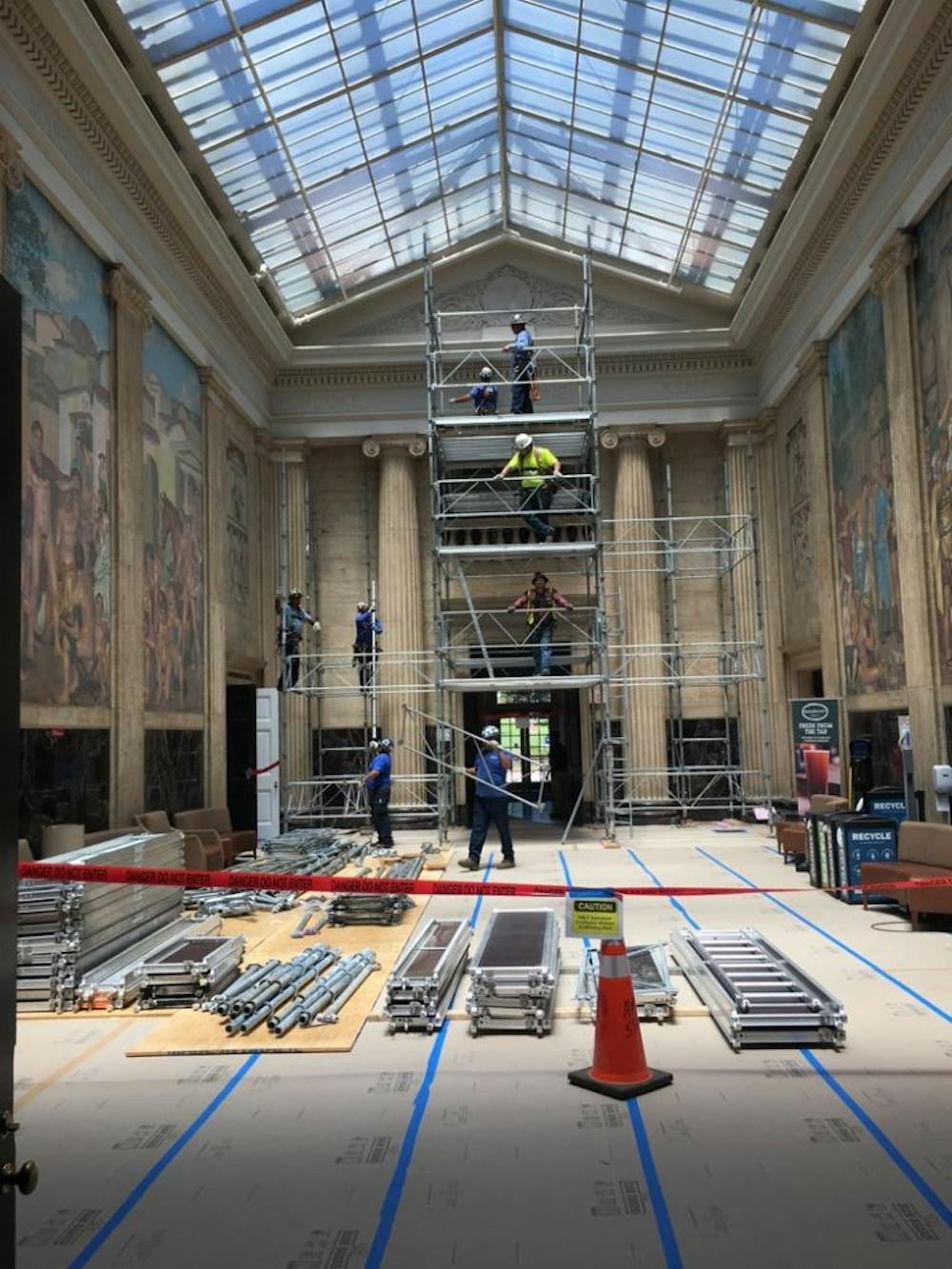Deep in the interior of Clark Hall, approximately 20 feet underground, stand the machines that control the heating, ventilation and air conditioning of the entire building, from the classrooms and offices to the library and laboratories. Few people have any reason to venture down to this subterranean space.
Yet, Jesse Warren, sustainability program manager for Buildings and Operations in the Office of Sustainability, led U.S. Department of Energy representatives to this very place on a tour July 16. As part of the DOE’s Better Buildings Challenge, a program to engage the public and private sectors in actively renovating residential, commercial and industrial spaces using energy conscious and cost-effective methods, the University completed a $2 million project from 2015 to 2018 to update Clark Hall’s energy and water infrastructure.
Improvements ultimately reduced annual energy and water expenditures by $750,000 or 65 percent and $22,000 or 79 percent, respectively. Annual utility consumption dropped from $1,199,000 to $435,000 over five fiscal years. As a result, the building became Leadership in Energy and Environmental Design certified, an honor that denotes significant strides made towards creating an efficient and green building. A plaque now resides in Clark Hall acknowledging this distinction. Additionally, the DOE, commended the University for its progress towards achieving the Better Buildings Challenge commitment of cutting energy use by at least 20 percent in 10 years.
“U.Va. is really leading the way in energy efficiency,” said Maria Vargas, director of the Better Buildings Challenge. “You are sharing your solutions for conserving energy locally, nationally and even internationally. In order to move further and faster as a country, it takes leaders showing others solutions… and the fact that you all are never done — that you keep working to improve — really distinguishes you.”
Since 2010, Office of Sustainability projects decreased energy inefficiency across Grounds by 13 percent and avoided over $35 million in energy fees. Past and ongoing restoration endeavors include replacing kitchen fume hoods in O’Hill Dining Hall, retrofitting lights in Campbell Hall and modifying HVAC systems in the Biomedical Engineering and Medical Science Building.
Clark Hall is the University’s most recent effort to maximize energy efficiency at the University. During the tour, Warren explained various facets of the initiative, beginning with the library. LED lights now fill the approximately 5,000 interior and exterior fixtures. Not only do these bulbs remain functional for 25,000-50,000 hours of use, Warren said, but they also have already translated to more than 50 percent in lighting energy savings.
“The bulbs use less energy and since they last for such a long time, we don’t need people going up there to replace them as often,” Warren said. “We have already seen a substantial return on investment in terms of energy savings and maintenance.”
In the basement, visitors inspected upgraded HVAC controls and valves. The switch from systems using compressed air to regulate heating, cooling and ventilation to digital, electronically-controlled HVAC systems and optimization of units that help circulate air accounts for $250,000 in savings from the University’s yearly energy bill.
Furthermore, numerous lab support spaces and offices benefited from ventilation updates. Repairs to the energy recovery ventilation system and adjustments to lower air flow rates for “dry labs” — labs lacking chemicals and fume hoods — spared the University more than $78,000 in annual costs.
Low-flow toilets and faucet aerators in all of the building’s restrooms contributed to the additional savings of $22,000 each year with respect to water usage.
Mechanical changes do not tell the full story of Clark Hall’s transformation, however. As Warren explained in the 2018 webinar hosted by the DOE titled “Financing Energy Projects in Higher Education,” the Office of Sustainability adopted a two-pronged approach to the project — the Buildings and Operations division of the Office of Sustainability focused on material renovations, and the Outreach and Engagement division spread awareness of green habits building occupants could incorporate into their daily routine.
“The Clark Hall project was our attempt to bring both halves of [the Office for Sustainability] together in order to really celebrate the energy savings and encourage the people in the building to have changed their behavior according to what we are trying to propose,” Warren said in the webinar.
Dana Schroeder, sustainability coordinator for Outreach and Engagement, agreed.
“We really wanted to galvanize folks in the space to be energy conscious,” she said.
Schroeder helped lead multiple activities to promote that value. For instance, multiple surveys gauged people’s views on topics, such as thermal comfort ranges and preferred methods of commuting to and from Grounds. Community feedback allowed building management staff to correct temperature settings and conserve extra energy and indicated that the majority of students walk, bike or take public transportation to travel around Charlottesville. Professors, library staff and others that frequent the building also had the opportunity to sign a pledge board, signifying their commitment to limiting their energy use.
Moving forward, Warren and Schroeder aim to continue these projects and start new ones, such as New Cabell Hall and the Claude Moore Health Science Library. Warren mentioned that the Office for Sustainability has already begun work on Thornton Hall, where they want to engage engineering students, faculty and staff in implementing innovative, environmentally-friendly systems, such as new HVAC controls. Above all, he emphasized the Office of Sustainability's goal both now and in the future to be a presence and advocate for conscientious, cost-effective energy practices.







